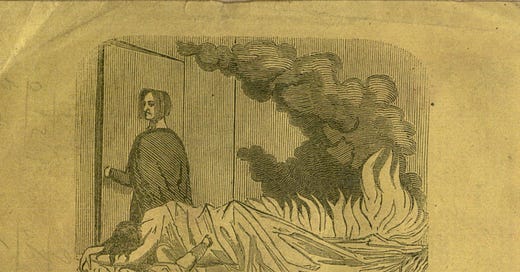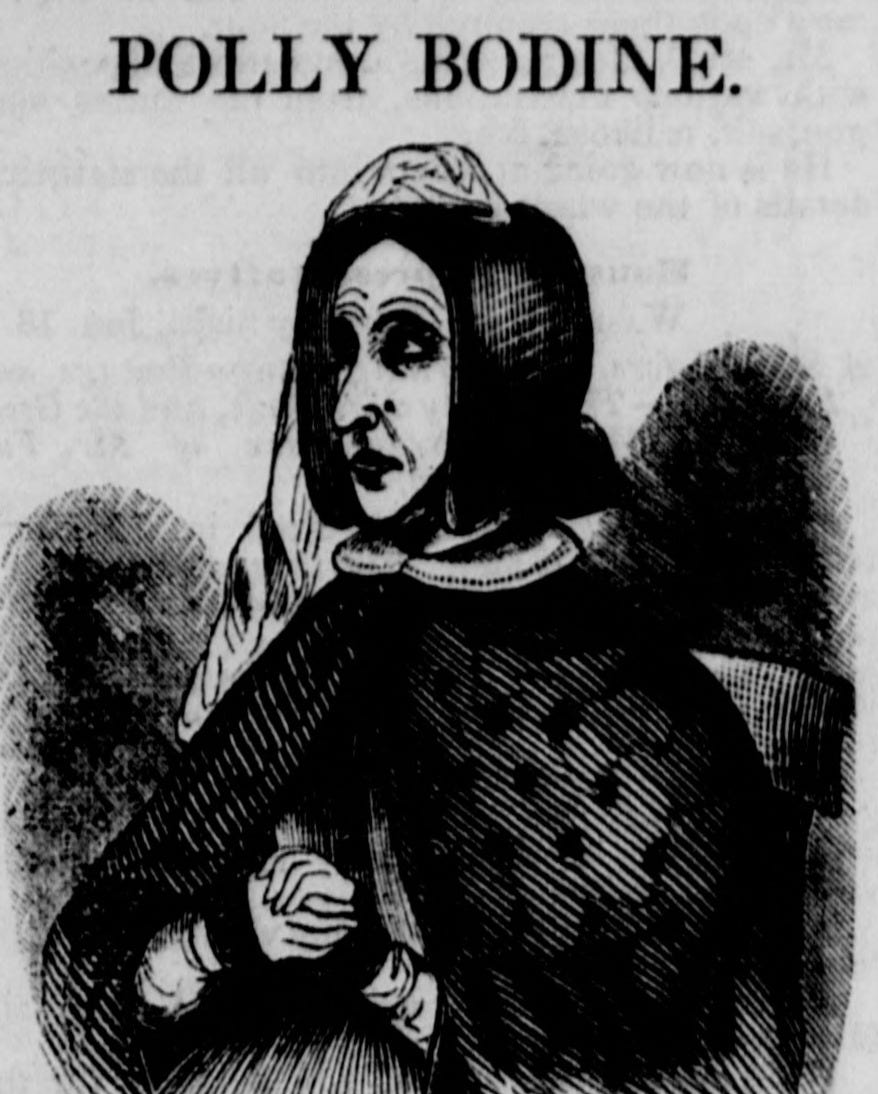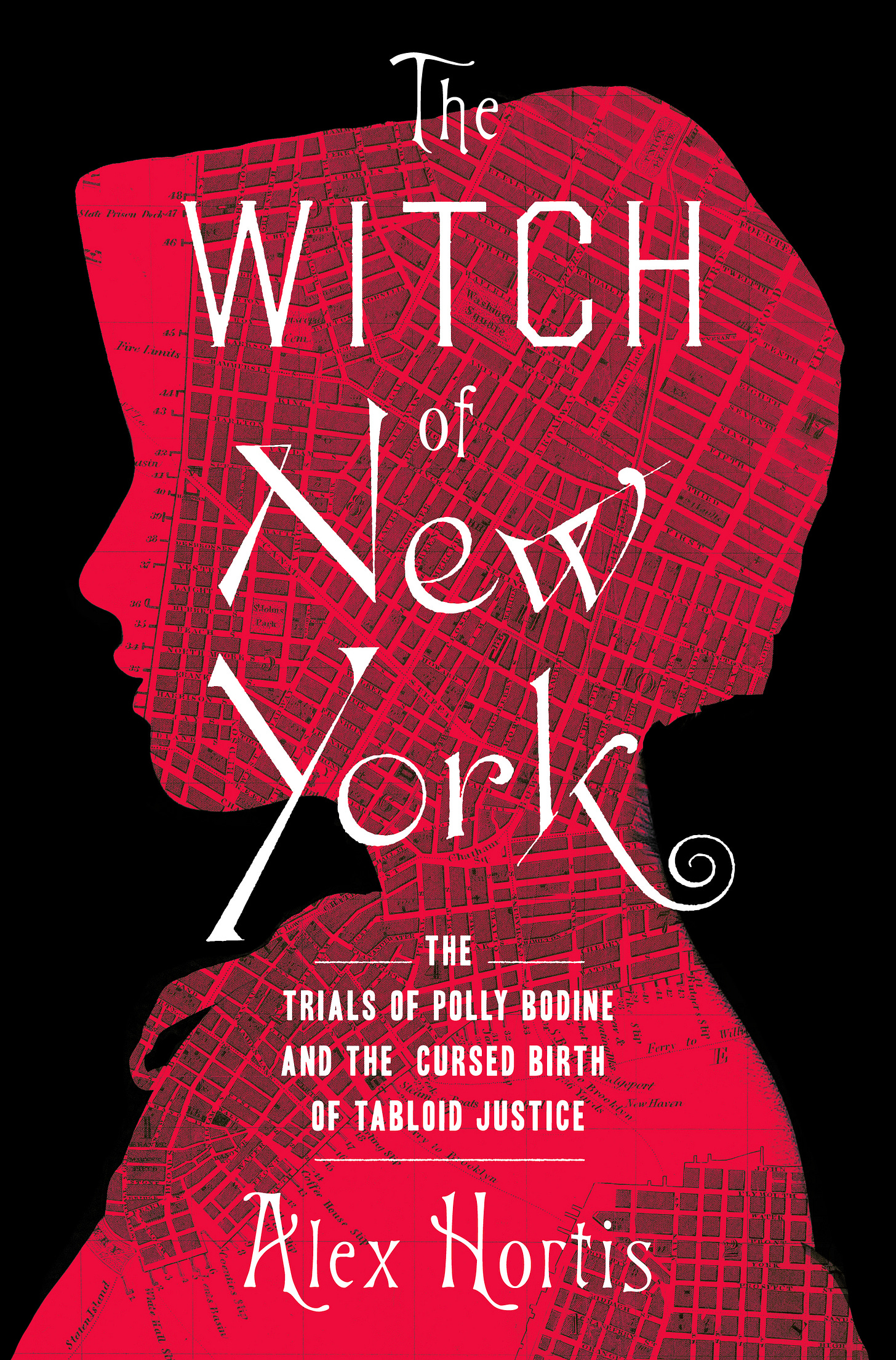Alex Hortis on THE WITCH OF NEW YORK
"The first woman put on trial for murder in a high profile media circus."
Welcome back to SOURCE NOTES, and allow me to present an interview I’ve been very excited about ever since a Vanity Fair colleague shared the book’s press kit way back in November. In THE WITCH OF NEW YORK, Maryland-based attorney and author Alex Hortis recreates the case of Polly Bodine, a mid-19th Century murder mystery and media circus that became one of America’s earliest instances of tabloid-style sensationalism. You can imagine how this one’s right up my alley given the thematic synergies with BLOOD & INK. (Fans of Patricia Cohen’s THE MURDER OF HELEN JEWETT, Daniel Stashower’s THE BEAUTIFUL CIGAR GIRL, and Paul Collins’ THE MURDER OF THE CENTURY are in for a treat as well.) Not to mention the crucial cameos from Edgar Allan Poe, Walt Whitman, and P.T. Barnum—because of course all those guys had a role to play in this saga. Let’s get into it with Alex—who spoke with me by phone a few weeks ago during a train ride to New York (more on that below)—shall we?
Start with the CliffNotes version.
Polly Bodine was the first woman put on trial for murder in a high profile media circus. As you know, the penny press started in the 1830s. There were a couple other cases before hers, Helen Jewett, of course, and Mary Rogers. But none of them, I believe, reached the level of intense interest that Polly Bodine’s case did. There were three trials. The first on Staten Island resulted in a hung jury. There was literally a runaway juror. Then they moved it to Manhattan, the belly of the beast, and here, James Gordon Bennett and Moses Yale Beach and P.T. Barnum essentially turned her into a witch-like figure. Not like Salem, but the equivalent of an evil woman, with some sexual undertones, who was an accused murderer and portrayed as ugly.
She was accused of murdering…
Her sister-in-law and her baby.
Polly’s niece.
Yeah, over Christmas 1843. It was a particularly horrific crime that attracted enormous interest. So she is convicted in Manhattan, but on appeal the New York Supreme Court overturns it, in large part over the issue of press prejudice. They questioned four thousand prospective jurors in Manhattan, and they couldn’t find an unbiased jury, so they sent it up to Newburgh for the third and final trial.
Let’s leave that as a cliffhanger. When did you first learn about this story?
After I wrote my first book on the mafia, I was looking for a new topic. I had been interested in tabloid trials, and I came upon this New York Times article about the case. They called it The Witch of Staten Island.
This was a modern New York Times article?
From 2000. It wasn't even a long article, but I couldn't believe it. P.T. Barnum was involved and Edgar Allen Poe. I vigorously hunted to see if somebody had written on it, and to my great surprise, nobody had done a full length book, and so I told my agent. I would argue it was probably the biggest historical true crime case that had yet to have a full length book, so I jumped on it.
When was this?
About 2014, 2015.
How do you juggle the research with your full-time job as a lawyer?
I would work on nights and weekends. At the time I was not married. And then—this is sort of depressing—I would take vacation time to go to do speed research at as many places I could. Fortunately there was a lot online because of Newspapers.com. But I still had to go to Albany, I had to go to Newburgh, I had to go to Staten Island. I did have to go on site and—you’ve written about this, those moments when you find that magic document or whatever. That's almost, like, thirty percent of the joy of the book.
What were some of those magic moments for you?
The New York State Archives had the original handwritten briefs for the motion to change venues. So there are all these affidavits from the 1840s that I am quite sure no one had looked at in a hundred seventy years. And it's just amazing to see the original handwriting, to see the characters, the figures, signing personal statements. Like, Polly had written that there were rumors that she was somehow having sex in prison as one reason to change venue. That was fresh. That didn't show up in the newspapers. Another cool moment—Newburgh was one of two places in the entire country that had the Newburgh newspapers, and that was crucial to the third trial because the New York City press had gotten tired of the case. So I turned up in Newburgh, which is a fairly beautiful town, and I sat down at this kind of rickety microfilm viewer and scanned it in and took pictures. I'm sure you've experienced this, when you kind of triangulate records. Sometimes I was like, is this an apocryphal story? But then you find something else that confirms it. So for example, there was a story that a juror had run away, literally a runaway juror. He jumped out of the window. I thought it was possibly apocryphal. Except then I did find a later newspaper account. A month after the trial he was indicted for absconding from the custody of the sheriff during the trial, and I was like, whoa! I couldn't believe that happened.
Aside from the newspapers, what were some places where you found good material?
The Library of Congress had some letters of the presiding judge. That was neat because he was complaining to his wife about how he had to work so late. Those little colorful details can be worth a thousand words. And then you go to the courthouse and it’s intact and it's beautiful and it looks pretty close to the original floorboards, the original structure. So you get in there and you learn things.
Which courthouse?
Staten Island.
Tell me some of the things you learned there.
For example, I could get the echoes, what it would've approximately sounded like. I could see the jury room. I could see how big the drop was when a juror went from the jury room down to the ground. I could see the chandeliers. Of course, there was no electricity, so they had to light wax candles, and so I added that as a detail to my book—the smell, the hissing of the flames and little details like that. I saw the original prison where Polly was jailed for two years, which was just a hellhole. Now it's like a tourist thing up in Newburgh, but it's just a complete hellhole, all rusted out. I saw the gravesite of the victims. They're buried together.
You had access to two court decisions. Are there any trial transcripts?
Not in the sense that they had stenographers, but the newspapers are damn close to a transcript. The New York Herald did a daily summary. It's not quite question-and-answer, but it's very, very detailed.
Which newspapers had the most fruitful material?
The Herald is number one. The Sun is number two; it's like a close second. The Sun was a little looser on ethics, and so they would have wilder stories, though the Herald was not a model of responsibility either. Then there was the Brooklyn Eagle, Walt Whitman's paper. They covered some of the Newburgh trial, so that was helpful. And then the Tribune, Horace Greeley's paper. By the time you get three or four newspapers and they basically agree on things, then you can get a pretty reliable account.
Those old articles are so long and there’s so much detail in terms of, like, movements and attire and stuff like that.
Yes. They were trying to entertain readers back then. They would describe when a baby starts crying, or they would describe when women start to hiss at Polly. They described what they were wearing, these colorful violets and all. They’re just full of these beautiful little details.
How accurate did you find the newspapers?
I thought the actual trial accounts were fairly consistent. I didn't find a huge divergence. What I did find inaccurate was when they're doing the tabloid thing. They were running rumors like, she had seven, eight abortions. How in the world do you confirm that?
Did you find any juicy material related to Poe and his coverage of the case? Anything that hadn't previously come to light?
I went to the Poe archives in Baltimore, and they just said, everything's online, you could just look online. There's nothing that hasn’t been found.
Was there anything you couldn't get your hands? Something that existed at one point in time and has been lost?
I would've loved to read the original appellate briefs written in handwriting by her attorneys, and that's gone. I went to the New York Municipal Archives. Supposedly they keep all arrest records going back even to the 1840s, just like little entries. I was looking for some cool detail, but they could not find it. They could find other people, but they could not find hers.
What was the most exciting part of the research?
Visiting the original courthouse. Actually, the reason I'm going to New York right now is because we're having a mock trial.
Fun.
Yeah. The Richmond County DA’s office is the prosecutor. We've got this good defense attorney. We're having witness actors in the original courtroom. The dress rehearsal is tomorrow. The actual mock trial is Friday, May 17th. It's being recorded—Community Media of Staten Island is filming and they're going to broadcast it. We're having a live audience in the original courthouse where she was tried one hundred eighty years ago to the date. You read about all these characters and they're going to come alive.
I love that.
It's going to be a lot of fun.







